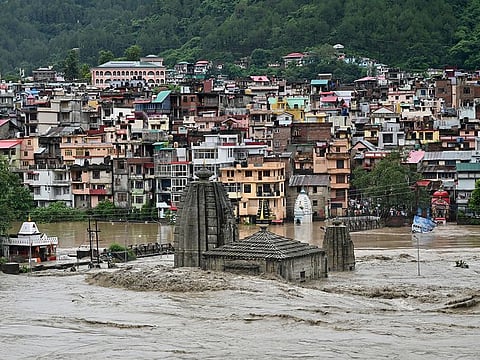Monsoon fury in India: Can the destruction be avoided?
Unless climate change is acknowledged as an unprecedented challenge, problems will remain

It took just a couple of hours for India’s capital to go under. As rain battered Delhi recording the wettest day in four decades, the city not surprisingly, struggled. Delhi is brought to its knees by almost every downpour seasonal or otherwise and it would have been unusual if it blustered through this severity.
Inundated, residential colonies had their access cut-off, roads caved in, and parks resembled slush. If there was an emergency, it was in no one’s hands and there could be more to come. The Yamuna River is now in spate and at its highest level in 45 years.
Submerged, luxury cars and three-wheelers had the same fate as rain became the great equaliser. It was a repeat of Bengaluru two years ago when residents of upscale homes were rescued on tractors.
Stranded citizens will tell you whether it is 12 hours deluge that accounts for 15% of the monsoon or an hour’s drizzle, Delhi’s inability to cope is legendary. Yet the city’s administrators behave as though it’s a recent phenomenon.
Voters are shortchanged
Waterlogging has been a perennial problem and to blame the intensity of the rainfall is to whitewash the underlying issues.
Heavy rainfall is part of a pattern, extreme weather conditions as India is currently witnessing are a climate change primer. For the uninitiated, global warming as a term is a misnomer as scientists warn warmer conditions caused by greenhouse gas emissions are leading to harsh and more frequent interventions by nature.
Almost annually, a part of the country has been at the mercy of torrential rain, which is intensified by climate change and scientists say it will only become worse unless the country becomes more ambitious about its 2070 net zero emission deadline.
The devastation could perhaps be contained better if it wasn’t for the man-made tinkering or in some cases like in Delhi, the lack of it. The old drainage system in the city has been unable for long to handle the increasing frequency of the rain.
As the volume of rainwater doesn’t completely empty into the Yamuna, Delhi often sees urban flooding and chaos. In the country’s hotspot political parties battle out for control of everything from civic amenities to law and order but the voter remains shortchanged. As you drive the city staring down at waterlogged roads are politicians from giant advertisement hoardings.
Heartbreaking repercussions
Across political parties no lessons seemed to have been learnt from previous tragedies and casualties are rising in the severity of the rainfall as it spreads to swathes in the north. There is another warning, hill stations in the country could bear the brunt of climate change and this year the forecast seems to be playing out.
Rain has been pounding the hill state of Himachal Pradesh which has been the worst affected with flash floods. Bridges are collapsing like ropes untied, entire homes are tumbling into a torrent of water and people have been killed in landslides as boulders have escaped to secure zones. Missed chances with some heartbreaking repercussions.
In 2014 the Kashmir Valley was submerged, in 2018 a million people were evacuated in Kerala floods, in 2022 it was the same story in Assam but the devastation in Himachal Pradesh has a similarity with Uttarakhand floods a decade ago.
Unregulated construction across India’s hill stations along with deforestation is exacting a price as new structures flout safety norms in the greed for increased tourism. Excessive construction and unprepared infrastructure have made these towns vulnerable, as rivers breach, civilisation is no longer isolated from danger.
India’s disaster management preparedness
In the colonial era town of Shimla, Himachal Pradesh’s capital city, 17 green belts have been given the go-ahead for construction by the government.
The seriousness to tackle climate change needs to begin at the top but despite the tragic outcomes, not many policy lessons have been learnt. Are rehabilitation packages implemented in their totality in previously affected places to forestall future disasters?
India’s disaster management preparedness is always playing catch-up instead of planning in advance. Evacuations are done only once lives are in danger and not when warnings are flagged. Despite the meteorological department alerts, was enough done to stall at least some repercussions that we have been witnessing in the last few days?
Unpredictability of weather conditions is a global test and predicting rogue patterns away from the set weather configurations a universal challenge. But there is a new normal and its inevitability could not be starker.
Cutting across party lines drainage, deforestation, or unplanned construction don’t seem to be an urgent agenda. Natural or man-made, when the capital city comes to a standstill every monsoon it puts paid to any assertions of being a country of the future.
Even Kartavya Marg that was renamed with much fanfare from its iconic name Rajpath is waterlogged. Unless policies are escalated, and climate change acknowledged as an unprecedented challenge it is only going to shine till the next rainfall.
Sign up for the Daily Briefing
Get the latest news and updates straight to your inbox




